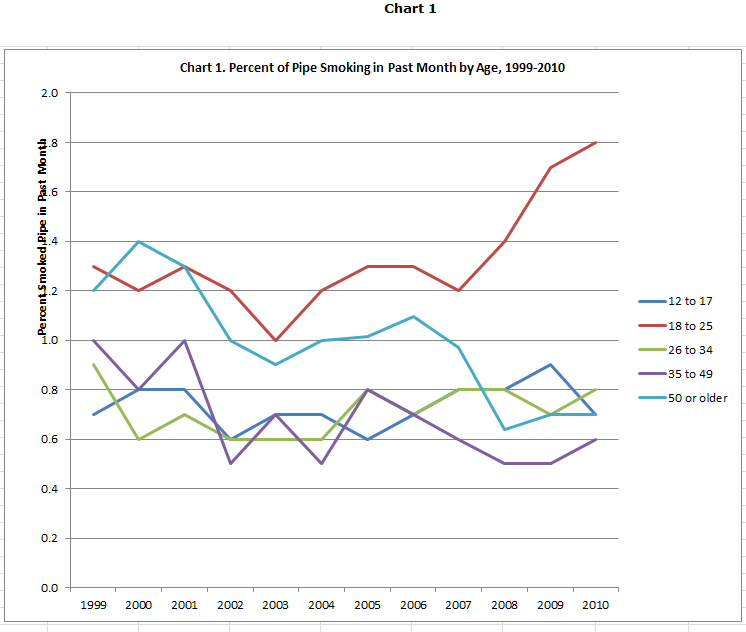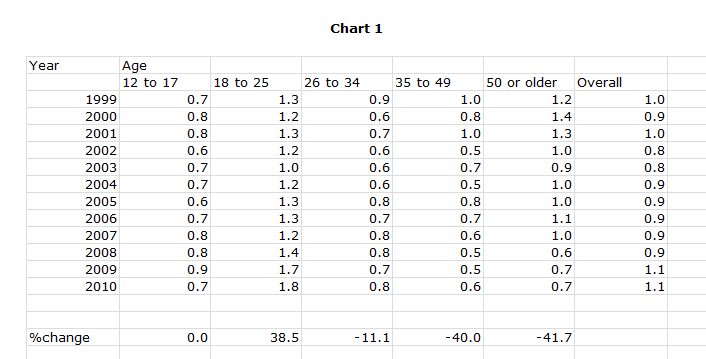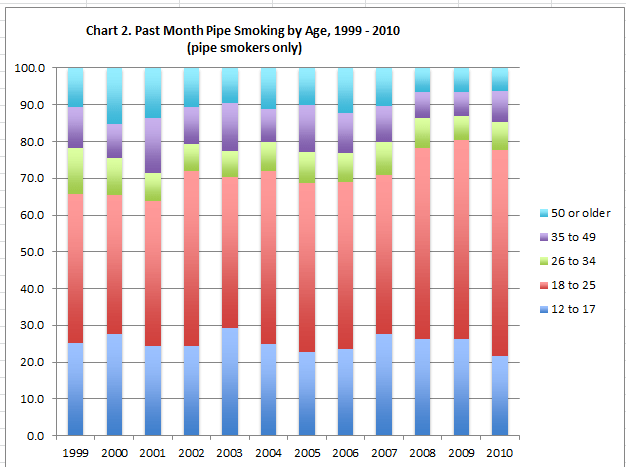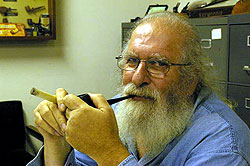Dr. Michael Garr, Ph. D. aka "Doc Garr"
 A frequently asked question among pipe smokers is whether pipe smoking among college-aged people is on the increase. Much of the information to answer the question is anecdotal. Nor has anyone to my knowledge looked at the ages of pipe smokers over a number of years.
A frequently asked question among pipe smokers is whether pipe smoking among college-aged people is on the increase. Much of the information to answer the question is anecdotal. Nor has anyone to my knowledge looked at the ages of pipe smokers over a number of years.
Using the National Survey of Drug Use and Heath (NSDUH), formerly the National Household Survey on Drug Abuse, the total number of pipe smokers and their ages can be fairly accurately estimated. The NSDUH is conducted under the auspices of the U.S. Department of Health and Human Services. Before 1999 the survey only looked at cigarette use. Starting in 1999, the survey was expanded to include a wide variety of tobacco use, including pipe use. The most recent year I had access to was 2010 and so the results presented below range from 1999 to 2010.
The sample, which ranges from approximately 53,000 to 58,000 respondents, is quite a large sampling. Sampling is done to ensure that the sample is representative of the entire nation.
I will show two charts. One shows the percentage of pipe smokers within each age category relative to the total sample of each age category. The second chart isolates just pipe smokers and shows the distribution of pipe smokers across the five age categories (12 – 17, 18 – 25, 26 – 34, 35 – 49 and 50 or older). The categories that are used are developed by NSDUH and are not my categories. Finally pipe smoking is confined to those who smoked tobacco in a pipe in the past month. Data can be obtained for last year or ever smoked a pipe, but using past month tends to focus on current smokers.


Chart 1 looks at the people who smoked a pipe in the past month as a percentage of the total sample for each of the age categories. Since 2003 there has been a fairly steady increase of people ages 18 – 25 who have smoked a pipe in the past month. In fact, pipe smoking in this age group increased to 1.8% from 1.3% during the 1999 to 2012 period. That is almost a 40% (38.5%) increase. During the same period, those between 12 to17 years of age basically remained unchanged. Every other age group saw declines in the percentage of pipe smokers (a 11.1% drop for those 26 to 34, a 40% drop for those 35 to 50, and a 41.7% drop for those 50 and older). It is surprising to see the dramatic drop for 50 or older group. Clearly, these findings suggest a fairly significant absolute increase among college-aged pipe smokers, ages 18 to 25.


Chart 2 examines the age distribution just among pipe smokers. Like Chart 1, this chart shows the increase of pipe smokers among the 18 to 25 age group relative to all other age groups, All other age groups show declines relative to the 18 to 25 age group. This again finds support for the increase of pipe smoking among those who are college-aged. . It is interesting to note, however, that regardless of year, more pipe smokers were college-aged than any other age group.
Overall, there has been a slight increase in pipe smokers over the period 1999 to 2010. In 1999, one percent of the population was pipe smokers. The percentage of pipe smokers decreased to 0.8% from 2002 – 2003. It increased slightly to 0.9% from 2003 to 2008. But then the percentage of pipe smokers jumped to 1.1% in 2009 and 2010. It is safe to say that this increase in the overall percentage of pipe smokers is due to the increase of pipe smoking among college-aged people.
Follow-Up Article: 2011 Youth Tobacco Survey
Another article by Doc Garr is: "The Ritual of Smoking a Pipe"

"Doc" is currently president of The United Pipe Clubs of America and Pocono Intermountain Pipe Enthusiasts. In 2011 Doc won the national slow-smoke championship in Chicago and competed in the World Cup in Eindhoven, Netherlands, where he came in 69th out of 338 smokers. He has been a pipe smoker for almost 25 years. When he is not smoking a pipe, Doc is Professor of Sociology at Wilkes University. He also moonlights at El Humidor, Wilkes-Barre, PA, a tobacco store. |














Look at all that red! Myself included at 24!
Very cool little study! I enjoy stuff like this.
I am not surprised that the majority of pipe smokers now is coming from the college aged group.
It is a surprise that the second largest group is 12-17! (if I’m reading correctly). I’d like to know how the data is collected (I assume the “head of the household” fills out the info)? That number (20% of pipe smokers!) seems unbelievable, although I do not question your method or analysis.
Even more interesting would be to do the math and calculate the absolute numbers from the study. The new Gandalf movies will provide a spike this year too.
hp
les
Yes, The Hobbit movies will certainly increase the interest in pipe smoking, Les.
Gray: This is a multi-staged probability-proportionate-to-size (PPS), starting off with a random sample of states. Within each state, there are regions that are sampled, within regions census tracts are sampled, and then finally household are sampled within census tracts. At the household level, household member is randomly selected with oversampling of 12-17 year olds resulting in a sample of 68,126. If you want more detail go to http://www.oas.samhsa.gov/nhsda/2k2nsduh/Results/appA.htm
“Lies, damned lies and statistics.” These numbers look entirely suspect and defy common sense. Doesn’t it strike you as odd or unbelievable that over 75% of all pipe smokers are between 12 and 25 years old? And of that group over 20% are 12-17? What self respecting teen smokes a pipe with tobacco in it? Not very damn many. Twelve year old pipe smokers? really? Whatever these 12-25 year olds are smoking in their pipes, I can assure you it is not pipe tobacco.
Before they outlawed tobacco shipments in my lunatic liberal state, the Washington State Department of Health tried to show us similar numbers of youthful pipe smokers. It was as ludicrous then as it is now. Its simply massaged data to justify progressive regulations and restrictions on all tobacco.
I thought the age distribution data from the PipesMagazine “Pipe Smoker Survey-2010” was more illuminating — even though some elderly and presumably less computer-literate smokers may have been systematically excluded. Kevin’s comment above, along with the concept of “youthful experimentation”, goes a long way toward explaining why the greatest increases of “in the past month” pipe smoking occurs among younger people.
.
This data may also be saying that, for whatever reason, non-pipe smokers who have attained the age of 26 are less likely to take up the pastime.
.
Regardless, it’s nice to have the stats as presented. Perhaps Doc Garr will offer a few hypotheses later.
This “children smoking pipes” idea really grates at my sense of honesty. Of course the occasional child experiments with pipe tobacco but these numbers are not credible in any way.
I am not a market researcher but methodology questions occur to me: if they interview head of households, what parent knows they’re children smoke a pipe unless they are hillbillies? And what child would admit to smoking a tobacco pipe?
I am delighted we get (adult) youthful pipe smokers in the hobby. How else would we carry on? But this studiy’s results and implications are preposterous. It has one sinister purpose: politics.
I think two issues are involved with why the age distribution turns out the way it does. First, whatever at-risk behavior you want to look at–drinking, using marijuana, driving fast–occurs most frequently in this age group. So often the issue is desistance when we become older. Second, young people have been looking for alternatives to cigarettes, whether it be pipes or hookah or snuff.
As for the credibility of the study, it is difficult to find a more credible study of drug use than the National Survey of Drug Use and Health. They do not interview the head of household. The handheld computer possessed by the interviewer randomly selects the member of the household to be interviewed, with overweighting for 12-17 year olds. Second, would you suggest Matt that all adolescents would lie about their pipe smoking? If not, then, what we have here is actually a conservative estimate. Finally, this is the study the CDC uses, and many other health agencies, in getting estimates of both legal and illegal drug use. You will find few critics of its methodology. I would recommend going to the website listed above and read more about the study and its methodology.
Doc, I’m simply saying this defies common sense and does not sound at all possible. If 20%+ of all kids smoke a tobacco pipe, why have we not seen it in any other cultural format? i.e. Facebook, Twitter, Pinterest, any online forums. And if 56% of all young adults –including women–smoke a tobacco pipe, then why don’t we observe that anywhere?
This giant herd of young pipe smokers ought to be observed somewhere — if they exist. Do you see them on TV, the street corner, the shopping malls, news media, new media, movies, you tube videos, animation, advertising? Ad agencies are super quick to pick up on trends and use them. According to this study young pipe smoking has been trending for over 10 years! I don’t recall seeing any advertisement depicting kids smoking pipes — although smoking per se is taboo. I see young people smoking marijuana, but never tobacco pipes.
If young people and teens are smoking tobacco pipes it ought to appear someplace other than this study. But it doesn’t. So what on earth could the study methodology reveal to account for this fiction?
Ah, I see where you are coming from Matt. Don’t forget that the total rate of pipe smoking in the population is 0.9% So the percentages you see are for that percentage of pipe smokers. So if a quarter of pipe smokers are young adults then that makes up only a little over 0.2% of the total population. So the above stats are just for pipe smokers not the entire population. And don’t forget even Ellen Page smoked a pipe in Juno!